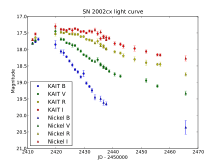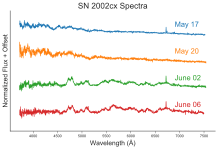SN 2002cx
SN 2002cx is a peculiar type Ia supernova.[6][7][8] It was discovered in May 2002 by a team of researchers from LBL.[2] It behaved differently from normal type Ia supernovae, and differently from several other previously observed peculiar type Ia supernovae including SN 1991T and SN 1991bg.[4][9]
| Other designations | SN 2002cx |
|---|---|
| Event type | Supernova |
| Spectral class | Peculiar Ia[1] |
| Date | 2002 May 12.21 UT |
| Constellation | Virgo |
| Right ascension | 13h 13m 49.72s[2] |
| Declination | +6° 57′ 31.9″[1][2] |
| Epoch | J2000 |
| Distance | Z of 0.024[3] |
| Redshift | 0.0236, 0.0244, 0.0241, 0.0242, 0.0243, 0.0249 |
| Host | CGCG 044-035[1] |
| Colour (B-V) | 0.04±0.05[4] |
| Peak apparent magnitude | +17.57±0.15[5] |
Discovery
SN 2002cx was discovered on 2002 May 12.21 UT by W. M. Wood-Vasey, G. Aldering, and P. Nugent of LBL with the Oschin 1.2-m telescope at Palomar.[1][2] On 2002 May 17.2 a spectrum taken by T. Matheson, S. Jha, P. Challis, and R. Kirshner of the CfA with the 1.5-m telescope at FLWO suggested it was a peculiar SN 1991T like type Ia.[1][10] SN 2002cx had photometric follow up taken at Lick using KAIT and the Nickel telescope, and further spectra were taken at FLWO and Keck.[1]
Features
Light curve

SN 2002cx hit maximum light in the B-band at 2452415.2 JD (2002 May 20.7) at 17.68, and in the V-band on 2452417.5 JD (2002 May 23) at 17.57.[11] The B-band light curve of SN 2002cx before 15 days after maximum evolves in a similar manner to SN 1999ac, brightening faster than SN 1991T but slower than SN 1994D or SN 2000cx.[9] SN 2002cx declines in brightness faster than SN 1991T and SN 2000cx in the B-band.[9] In the V-band SN 2002cx is similar to SN 1999ac until 30 days after max.[9] Again SN 2002cx declines faster in the V-band than SN 1991T, but slower than is typical for a type Ia.[9]
SN 2002cx is peculiar in the R-band, as it brightens very fast in a manner wholly different from SN 1999ac.[12] It has no secondary maximum in R-band as expected if it were similar to SN 1991T, but instead has a plateau after max.[12] The R-band also declines more slowly than normal.[12] The I-band behaves similarly to the R-band, with a quick brightening, a plateau and slow decline.[12] While a plateau in the I-band is expected for sub-luminous supernovae, the following slow decline is not.[12]
Spectra

The first spectrum of SN 2002cx was obtained with FLWO on 2002 May 17, 4 days before B-band max.[13] At this point SN 2002cx is similar to SN 1997br as both have a blue continuum, with absorption lines from Fe III λ4404 and Fe III λ5129.[13] Si II λ6355 though is not apparent in SN 2002cx at this point, and it has very weak Ca II H & K lines suggesting that SN 2002cx is similar to SN 1991T which also lacked such lines.[13] This spectrum for SN 2002cx has a low expansion velocity measuring only ~6400 km s−1.[13] This marked one way in which it was different from SN 1997br, as SN 1997br's expansion velocity was ~10,400 km s−1 at the same point relative to its own B-band maximum.[13] At the time of measurement SN 2002cx's expansion velocity was the lowest measured for an early time type Ia,[13] Another spectrum taken on 2002 May 20, 1 day before B-band maximum light, showed little evolution from the one taken on 2002 May 17.[14]
Four later spectra were taken on June 2, June 6, June 12, and June 16 at FLWO.[15] The spectrum of SN 2002cx has evolved by this point to have a redder continuum.[15] It has also lost the Fe III absorption lines and its Fe II lines have gained prominence at λ4555 and λ5129.[15] The Ca II H & K lines continue to remain weak, a further departure from SN 1997br.[15] Unlike another type of sub-luminous type Ia, SN 1991bg, SN 2002cx does not show Ti II lines around 4100-4400 Å.[15]
Spectra were taken at Keck corresponding to 20, 25, and 26 days after maximum light in the B-band.[16] So little evolution was observed between these spectra that they were all combined in order to increase the signal-to-noise ratio and study less pronounced features.[16] Fe II still dominates the spectrum.[16] The Ca II infrared triplet is weak in SN 2002cx as compared to other type Ia supernovae, as expected since the Ca II H & K line is also weak in SN 2002cx.[16] Unlike other type Ia supernova, SN 2002cx has double-peaked emission lines which may be due to jet-like emissions or rotating ejecta, or may simply only be seen in SN 2002cx because its low expansion velocity does not wash them out.[16] The emission or ejecta hypothesis is considered less likely because if it were the case all the peaks should share equal separation, which they do not.[16][17] SN 2002cx has absorption and emission lines between 6400 Å and 7000 Å that are unique among previously discovered type Ia supernovae.[17]
A final spectrum of SN 2002cx was taken on July 16, 56 days after B-band maximum.[18] SN 2002cx was by then in the nebular phase, with emission lines dominating over absorption lines.[18] The lines were far narrower than previously observed type Ia supernovae and are less pronounced as well.[18] SN 2002cx most clearly differs from other type Ia supernovae in the region between 6500 Å and 8500 Å where it has a primarily flat continuum and weak Ca II infrared triplet absorption.[18] Because this is the region covered by the R and I-bands, it may explain the odd color evolution of SN 2002cx in these bands.[18]
SN 2002cx did not evolve much between 4 days and 1 day before max, not did it evolve much from 12 days after max to 27 days after max,[15] However, it underwent dramatic evolution during the two weeks after maximum light in the B-band.[15]
Based on the odd behavior of SN 2002cx's spectrum there are some questions as to whether it is a type Ia supernova or not.[19] Although it does not show Si II lines neat 6150 Å as is required of a type Ia, SN 2002cx's evolution is explainable using the paradigm of other type Ia observations and so Li et al. consider their classification as a type Ia as secure.[19]
Color
SN 2002cx does not suffer from much host related reddening, as evidenced by its very blue spectra.[4] It is extinct in B-V color by 0.034 magnitudes from dust in Milky Way.[4]
SN 2002cx is similar to SN 1999ac in B-V at max, but also at times as late as 50 days after max which is unexpected as the two supernovae evolve differently at late times.[4] SN 2002cx has a B-V color of -0.04±0.04 at 4 days before max, and 0.04±0.05 at the time of max in the B-band which is bluer than SN 1991bg at the same time.[4] The color of SN 2002cx is consistent with Lira-Phillips law at late times.[20]
The V-R color of SN 2002cx evolves similar to other type Ia supernovae before 5 days after max, although it is somewhat redder.[20] After 5 days after max SN 2002cx gets progressively redder, although still slightly bluer than SN 1991bg.[4] At 25 days after max SN 2002cx continues to redden, while SN 1991bg starts to get bluer.[4]
SN 2002cx's V – I color is red for all times, only slightly bluer than SN 1991bg before 25 days after max, and redder after 25 days after max.[4]
References
- Li et al., 2003 p. 5
- Wood-Vasey et al., 2002
- Li et al., 2003 p. 14
- Li et al., 2003 p. 12
- Li et al., 2003 p. 58
- Li et al., 2003 p. 1
- Branch et al., 2004
- Jha et al., 2006
- Li et al., 2003 p. 10
- Matheson et al., 2002
- Li et al., 2003 p. 9
- Li et al., 2003 p. 11
- Li et al., 2003 p. 15
- Li et al., 2003 p. 16
- Li et al., 2003 p. 17
- Li et al., 2003 p. 18
- Li et al., 2003 p. 19
- Li et al., 2003 p. 20
- Li et al., 2003 p. 24
- Li et al., 2003 p. 13
Bibliography
- Branch, David; Baron, E.; Thomas, R. C.; Kasen, D.; Li, Weidong; Filippenko, Alexei V. (October 2004). "Reading the Spectra of the Most Peculiar Type Ia Supernova 2002cx". Publications of the Astronomical Society of the Pacific. 116 (824): 903–908. arXiv:astro-ph/0408130. Bibcode:2004PASP..116..903B. doi:10.1086/425081.
- Jha, Saurabh; Branch, David; Chornock, Ryan; Foley, Ryan J.; Li, Weidong; Swift, Brandon J.; Casebeer, Darrin; Filippenko, Alexei V. (July 2006). "Late-Time Spectroscopy of SN 2002cx: The Prototype of a New Subclass of Type Ia Supernovae". Astronomical Journal. 132 (1): 189–196. arXiv:astro-ph/0602250. Bibcode:2006AJ....132..189J. doi:10.1086/504599.
- Li, Weidong; Filippenko, Alexei V.; Chornock, Ryan; et al. (April 2003). "SN 2002cx: The Most Peculiar Known Type Ia Supernova". Publications of the Astronomical Society of the Pacific. 115 (806): 453–473. arXiv:astro-ph/0301428. Bibcode:2003PASP..115..453L. doi:10.1086/374200.
- Matheson, T.; S. Jha; P. Challis; R. Kirshner (2002-05-17). "Circular No. 7903". Central Bureau for Astronomical Telegrams. Retrieved 2011-07-05.
- Wood-Vasey, W. M.; Aldering, G.; Nugent, P. (2002-05-17). "Circular No. 7902". Central Bureau for Astronomical Telegrams. Retrieved 2011-07-05.